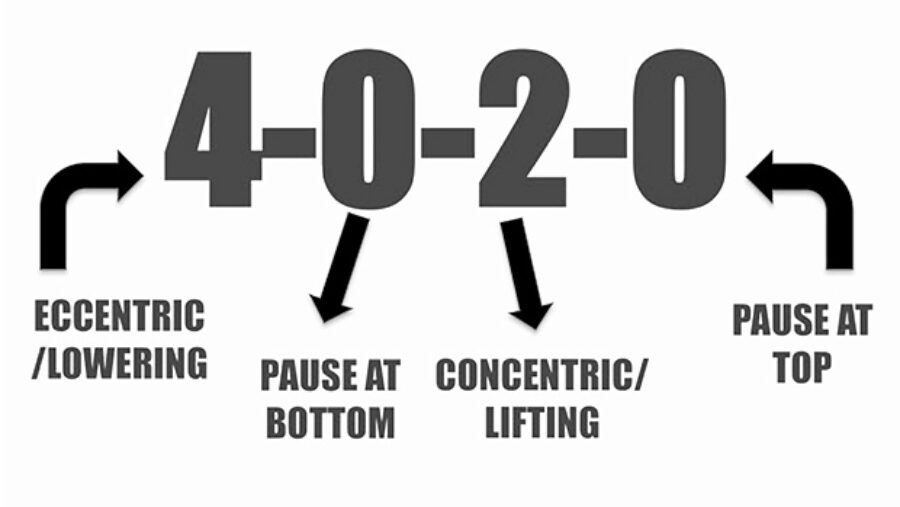What is Lifting Tempo?
Fast vs. Slow Reps For Muscle Growth
Rep tempo refers to the speed at which you're lifting.
This training protocol has become very popular in the recent years. Many people believe it's an effective way to get better results.
In this article we will talk about lifting tempo and the impact it has on muscle growth.
When you're lifting, you can do repetitions with slow and controlled movements or you can perform them in a fast and explosive manner.
This is called rep/lifting tempo.
We can break a repetition in 4 different phases:
- Eccentric: lowering the weight and lengthening the muscle (lowering a barbell when doing bicep curl)
- Isometric: bottom part of a movement (pause) when the muscle is stretched (bottom position when doing a bicep curl)
- Concentric: lifting the weight and contracting (shortening) the muscle (lifting the barbell when doing a bicep curl)
- Isometric: top part of a movement (pause) when the muscle is contracted (top position when doing a bicep curl)
Each of this phase can be assigned a tempo.
Here's standard tempo that most people use without knowing 2-0-2-0:
- 2 s eccentric (lowering)
- 0 s pause at the bottom
- 2 s concentric (lifting)
- 0 s pause at the bottom
This protocol was created by strength coach Charles Poliquin and has benefits that we will explore in the next sections.
It's very common to hear people recommending excessively slow down the speed of the eccentric (lowering) part of a rep.
This is because research has shown that is possible to build more muscle by doing eccentric (only) training.
However, this type of training doesn't necessarily translate due to the tools used in the lab vs. the equipment available in a gym.
You can still focus on eccentric training at the gym, such as performing the negative (lowering) part of a pull up if you can't perform a full one.
This will help you build more muscle, but you will still be as strong as your weakest link; your concentric strength (lifting) part of a pull up.
Time under tension (TUT) is how long your muscle is being activated.
It would simplistic to conclude that the more time under tension there is, the more muscle growth there will be.
However, studies have shown that more time under tension doesn't mean better stimulus (muscle growth).
If you take a light weight and you perform a rep tempo of 4-0-2-0. It would result in more time under tension than if you did a 2-0-2-0 with a heavier weight. However, the heavier weight would lead to better stimulus.
Moreover, if you take this same example with the same weight, but different eccentric duration. You'll certainly end up doing less reps on the 4-0-2-0 than the 2-0-2-0, due to the fatigue accumulated throughout the slow eccentric part of the repetition.
This will make you have more time under tension, but less training volume, thus less hypertrophy (muscle growth).
The bottom line is, just lift weights in a controlled manner (2-0-2-0), but don't try to slow it down excessively. Otherwise, this will increase fatigue and decrease your training volume.
Similarly to myo-reps, lifting tempo is a tool that can be useful in certain cases.
For example, if you perform an activity that requires power (such as boxing), you could focus on doing explosive concentric movements. The rep tempo could look like: 3-0-1-0
You could also do pause squats to be specific and strengthen certain parts of the movement, which will help you build other muscle groups. The rep tempo could look like: 2-2-2-0
Or slow down the speed of your squat in order to make sure you're performing an exercise with good form. The rep tempo would look like: 4-1-4-1
- Improves technique
- Makes working out more challenging
- Increases endurance
- Increases fatigue
- Taxing on the CNS
- Less training volume than traditional rep tempo
- Rep tempo is the speed at which you're lifting
- There are 4 phases in a repetition: eccentric (lowering), isometric (bottom), concentric (lifting), isometric (top)
- You can get build muscle by doing eccentric training, but you will still be as strong as your weakest link; your concentric strength
- Slow rep tempo can lead to more fatigue and less training volume than traditional rep tempo
- Rep tempo can be beneficial if you want to work on certain parts of a lift, switch things up or increase your endurance
